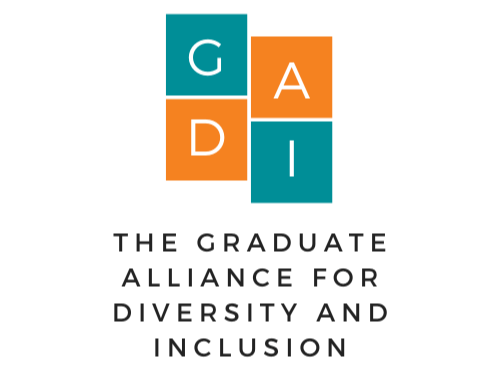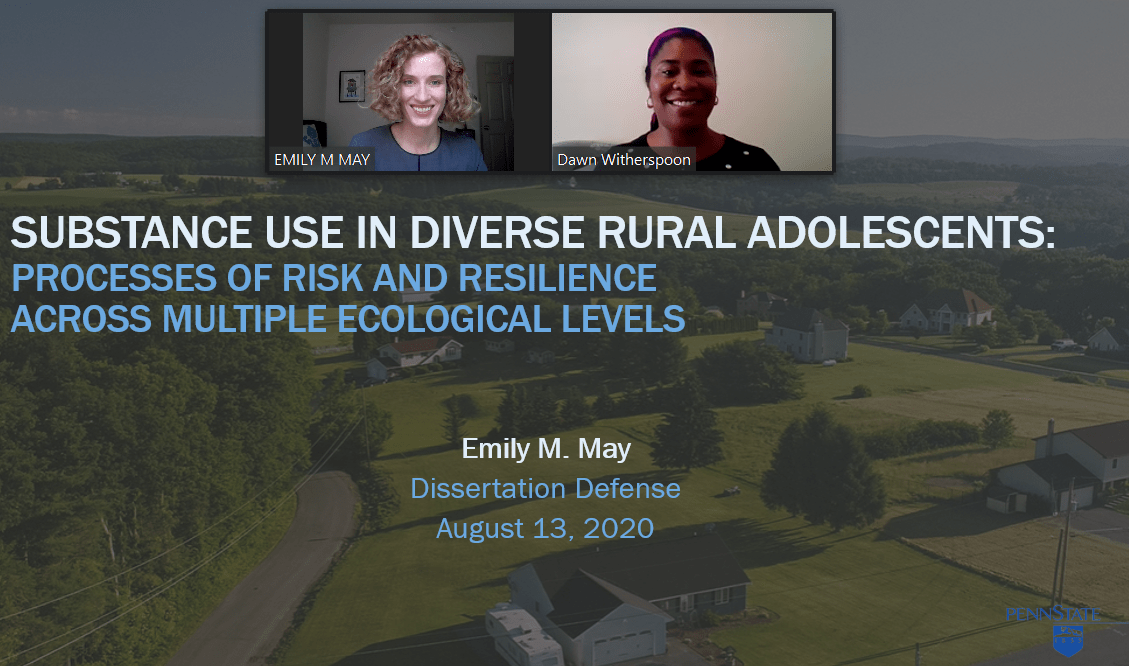SPOTLIGHT
Spotlight
Dawn Witherspoon participates in Carolina Seminars
Dr. Dawn Witherspoon was the discussant for Carolina Seminars – The Double Whammy: The Disproportionate Impact of Systemic Racism and COVID on Children of Color held April 30. The Carolina Seminar Series aims to increase awareness about the impact of disparities that contribute to children’s ability to keep pace, which have broad dire effects on the neurodevelopmental trajectories of children growing up in disadvantaged households and communities.
Wei Wei receives GADI Research Award!
Wei Wei was awarded the Graduate Alliance for Diversity and Inclusion (GADI) Research Award for her paper titled “Chinese American Adolescents’ Academic Performance and Psychological Adjustment: The Role of Neighborhood and Family.” This award celebrates graduate students pursuing challenging topics around diversity, inclusion, and social justice. Congratulations Wei!

Dr. Naila Smith receives AAUW American Fellowship!
Dr. Naila Smith, CDL postdoc, was selected as a recipient for the AAUW American Fellowship for the 2021-22 award year. AAUW is one of the world’s largest sources of funding for graduate women and have a competitive and selective awarding process. With this fellowship, Dr. Smith will pursue her project on Black girls’ socioemotional learning. Congratulations Dr. Smith!

Context and Development Lab at SRCD!
CDL members will be presenting their research at SRCD’s 2021 biennial meeting. Check out the following presentations:
Environmental Risk Exposure and its Effects from Infancy to Adolescence: Differential Susceptibility to Context (Paper Symposium)
- Date: Wed, April 7, 11:35am to 1:05pm EDT
- CDL Members Presenting: Dr. Dawn Witherspoon (Chair), Wei Wei (Presenting Author)
- Abstract: The symposium brings together cutting-edge research to explore contextual risk factors to inform our understanding of how to enhance children and youth’s well-being. Presentations will focus on contextual (i.e., maternal and neighborhood) exposures from the prenatal period to adolescence, examining how early environmental risk may impact later child development. The first presentation uses two studies to examine how prenatal inflammation impacts cognitive development during childhood. Findings demonstrated that prenatal infection and inflammation was associated with more communication disorder and hyperactivity symptoms during childhood (i.e., 8 years) as well as lower Bayley scores at 12 months. The second presentation explores how environmental toxins, air pollution, during the prenatal period impact inhibitory control during childhood and academic achievement during early adolescence. Results showed a mediation process such that that the impact of higher air pollution exposure on lower academic performance was explained by inhibitory control in girls only. The last presentation examines how the timing of residential moves during childhood and adolescence impacts internalizing and externalizing behaviors as well as academic achievement. Contrary to expectations, findings demonstrated that moving during childhood and adolescence was positively associated with academic performance. However, during adolescence, moving was also associated with more internalizing symptoms. Together these studies continue to advance developmental science using interdisciplinary scholarship and diverse samples to show differential susceptibility to and implications of environmental risk. The discussant will highlight the implications of the ECHO (Environmental Influences on Child Health Outcomes) program’s collective work and provide recommendations for future studies to address lingering questions.
Ethnic-Racial Socialization in Multiple Contexts in Adolescence: Families, Peers & Schools (Paper Symposium)
- Date: Thu, April 8, 10:00 to 11:30am EDT (10:00 to 11:30am EDT)
- CDL Members Presenting: Dr. Dawn Witherspoon (Discussant)
- Abstract: Ethnic-racial socialization (ERS) has been operationalized as the transmission of beliefs, values and practices surrounding race (Hughes et al., 2006). Although family ERS is positively associated with youths’ psychosocial outcomes, more work is needed to further our understanding of ERS across contexts and developmental periods. This symposium focuses on ERS in family, peer, and school contexts among early through late adolescents. Socialization has been studied with regards to youth’s psychosocial functioning, but few have examined how ERS relates to race in youths’ friendships. Study one examines how parent ERS can play a role in friend/peer selection in early adolescence. Additionally, although ERS has been examined in relation to youth’s perception of the content of messages, less is known about parents’ competency in providing those messages. The second study utilizes a latent profile approach to explore both content and competency among African American parents’ ERS practices. Finally, it ERS may be an important factor for buffering the effects of racial discrimination on academic outcomes. While studies have examined how current discrimination is associated with academic outcomes, less is known how past discrimination in school impacts African American youth’s college outcomes and how different dimensions of ERS can buffer the effects. Both qualitative and quantitative methods were utilized in these papers to understand the impact of socialization within these various populations. This group of papers adds to the literature on ERS in African American populations by discussing crucial areas that are in need of further investigation.
Objective and Subjective Approaches to Examining Neighborhood Environments for Youth Development (Paper Symposium)
- Date: Fri, April 9, 2:45 to 4:15pm EDT
- CDL Members Presenting: Shadane Johnson & Tiyobista Maereg (Presenting Authors)
- Abstract: Neighborhood contexts are salient for youth development (Leventhal, Dupéré, & Shuey, 2015). There are a variety of approaches to examining neighborhood effects, including objective (e.g., census data, systematic social observations) and subjective (e.g., self-report) measures. Across the papers, researchers explore a range of developmental constructs (e.g., socialization, ethnic-racial identity, self-regulation) within the context of various neighborhood characteristics (e.g., ethnic-racial compositions, socioeconomic disadvantage) using diverse methods (e.g., census data, systematic social observations, survey, qualitative interviews). Paper 1 examines whether objective and subjective neighborhood characteristics moderate the association between ethnic-racial socialization and social, emotional, and cognitive development among Latinx and Black adolescents. Paper 2 characterizes patterns in exposure to diverse ethnic-racial compositions across mothers’ neighborhoods and activity spaces and relates these to maternal socialization of Latinx adolescents. Paper 3 uses systematic social observations in Google Street View to examine how characteristics of the school neighborhood environment are related to youths’ self-regulatory skills. Paper 4 uses quantitative and qualitative methods to compare and contrast assessments of Latinx neighborhood characteristics as observed by researchers’ objective systematic social observations and U.S. Mexican adolescents’ subjective narratives. Collectively, the papers utilize various approaches to assess neighborhood factors and shed light on the implications of neighborhoods for development across diverse youth.
Examining the Risk and Protective Factors of School Behavior Problems and the Consequences for Black Girls (Poster Presentation)
- Date: Wed, April 7, 7:45pm to 10:45pm EDT
- CDL Member Presenting: Victoria Francois (Presenting Author)
- Abstract: Black girls are disproportionately affected by harsh school disciplinary action and the school-to-prison-pipeline. While previous studies have focused on Black boys, Black girls are a fast-growing, yet overlooked population in the juvenile justice system whose voices and experiences are often muted (Morris, 2012). The purpose of the current study is to investigate if perceived discrimination, parenting, and ethnic-racial socialization (ERS) act as protective or risk factors for school behavior problems and the consequences of suspension/expulsion in Black girls. The Maryland Adolescent Development in Context Study (Ngirls=410) was used to test the following research question: How do perceived discrimination, parenting, and ERS act as risk or protective factors for school behavioral issues and the consequences in Black girls? More specifically understanding (1) the associations that discriminative experiences, ERS, and parental warmth, monitoring, and school-based involvement have with school behavior problems and suspension/expulsion, and (2) whether ERS and other parenting practices moderate the association between discrimination and Black girls’ school behavior problems and disciplinary action. A linear and logistic regression were conducted to investigate the relationship between the variables of interest. Results showed that there was a significant relationship between racial discrimination, parental warmth, and the interaction between both of those variables on school behavior problems. Parental warmth was also significantly associated with suspension/expulsion. Findings additionally revealed that socioeconomic status was significantly associated with both school outcomes.
Resilience! The Impact of Cultural Stressors and Assets on Latino Adolescents’ Academic Beliefs and Performance (Poster Presentation)
- Date: Thu, April 8, 3:15 to 4:15pm EDT
- CDL Member Presenting: Hannah Cotto (Author)
- Abstract: Latino youth (LY) have high educational expectations, yet there is an evident academic achievement gap that separates them from their non-Hispanic peers (Witherspoon & May, 2019). Ethnic-racial socialization (ERS) can moderate the negative influence of discrimination, prejudice, and racism on LY’s academic performance and beliefs (i.e., academic outcomes [AO]) (Grindal & Nieri, 2015). Nevertheless, research exploring cultural stressors and assets that may lessen this achievement gap is arguably incomplete, particularly among LY in new destination contexts (i.e., non-traditional immigrant settlement areas). The integrative model (García Coll et al., 1996) proposes that neighborhood’s effects on cultural stressors can influence LY’s AO. Is it suggested, that parent and youth perceived discrimination influence youth ERS (i.e., preparation for bias, promotion of mistrust, cultural socialization) and in turn, ERS positively predicts LY’s AO (Benner & Graham, 2011; Farzana et al., 2016). ERS has also been suggested to moderate the effects of discrimination on African American students’ AO (Neblett et al., 2016). Few studies (e.g.,Stein et al., 2014) explore LY’s individual and contextual factors in non-traditional settlement areas. More research must explore the interactive impact of cultural stressors and strengths on LY’s AO in new destinations given the increased probability of LY living there. Therefore, the current study examines if parent and youth perceived discrimination is associated with LY’s AO; if ERS is associated with LY’s AO; and if ERS moderates the association between discrimination and AO. It is hypothesized that 1) parental and youth perceived discrimination will be negatively correlated with AO; 2) ERS will be positively associated with AO; and 3) ERS will moderate the relationship between discrimination and AO. The present study’s data was drawn from a project focused on neighborhood and LY development. See Tables 1 and 2 for participant demographics and measures, respectively. Reliability and exploratory factor analyses (EFAs) confirmed the measures’ reliability. Pearson correlations determined associations between variables. With two hierarchical regression models for parental discrimination and two for youth discrimination, SPSS 25.0 will be used to test the hypotheses. Academic performance and academic expectations are the dependent variables; demographics covariates (i.e., gender, age, ethnicity, generational status) will be included at step 1. Parent or youth discrimination will be included at step 2 in two separate models to explore correlation with AO (hypothesis 1). ERS dimensions will be included at step 3 to examine associations with AO (hypothesis 2). Two-way interactions between parent/youth discrimination will be included at step 4 to see if ERS moderates the association between discrimination and AO (hypothesis 3). Any significant interactions will be probed with simple slope analysis. All the data for the current study has been collected. A methodologist will assist with the analyses and interpretation. These factors ensure data analysis completion before the SRCD biennial meeting. Ultimately, this study may offer insight into the complex association between parent and youth’s discrimination experiences and ERS and their effect on AO Latino families’ AO in new destination contexts. Potentially providing greater knowledge to formulate action plans that may decrease the academic achievement gap.
Examining the Risk and Protective Factors of School Behavior Problems and Suspension/Expulsion in Black Girls (Poster Presentation)
- Date: Fri, April 9, 11:45am to 12:45pm EDT
- CDL Member Presenting: Victoria Francois (Presenting Author)
- Abstract: Black girls comprise 8% of K-12 enrollment, but 13% of all suspended students (Epstein et al., 2017). Many studies investigating racial disparities in disciplinary action focus on Black boys (Ispa-Landa, 2013; Morris, 2012). Fixating on the school-to-prison pipeline for Black boys mitigates the negative experiences of Black girls. Black girls are more likely to receive office referrals for subjective behaviors like disobedience, defiance and assault than other children (Annamma et al., 2019; Epstein et al., 2017). The Integrative Model (Garcia-Coll et. al, 1996) and Critical Race Theory (Evan-Winters and Esposito, 2010) suggest that there are protective and risk factors of school behavior problems and suspension/expulsion for Black girls. Some studies suggest that perceived discrimination is positively associated with school behavior problems and suspensions/expulsions (Koonce, 2012; Murphy et al., 2013; Butler-Barnes and Innis-Thompson, 2020). Other work shows that positive parent-child relationships (PRC) and ethnic-racial socialization (ERS) are negatively associated with school behavior problems and suspensions/expulsions (Bean et al., 2006; Hair et al., 2008; Marcucci, 2020; Varner et al., 2019). The current study’s goal is to investigate whether perceived discrimination, ethnic-racial socialization, and the parent-child relationship act as protective or risk factors for Black girls’ school behavior problems and suspensions/expulsions. We hypothesize that discrimination will be positively associated with the outcomes, whereas ERS and PCR will be negatively associated with the outcomes. Also, we hypothesize that ERS and PCR will moderate the impact of discrimination on school behavior problems and suspensions/expulsions. Data for the current study were drawn from the Maryland Adolescent Development in Context Study (Eccles, 1997) and included 410 Black girls (Mage =12.24, SD=0.55), from diverse socioeconomic backgrounds (comprised of the highest level of education, occupation status, and family income) Adolescents and caregivers responded to interviews and questionnaires. See Table 1 for present study measures. Planned analyses include: (1) bivariate correlation tests to examine whether there are associations among variables of interest (2) two hierarchical regression analyses conducted in SPSS—school behavior problems and suspension/expulsion (logistic) as dependent variables and perceived discrimination as a risk factor. ERS and PCR (protective) will be the predictors as well as their interactions with discrimination. Covariates include SES and youth age. The data analysis will be completed before the SRCD conference as this is part of an ongoing McNair research project which is due in November. The co-authors will support data analyses. In sum, this study places more emphasis on Black girls’ experiences and may reveal if PRC, ERS and discrimination impact their school behavior and the consequences. If hypotheses are supported, this study has implications for how teachers can work to better understand Black girls and create more positive environments focused on family-school collaboration, which may help reduce racial disparities in school disciplinary actions.

Congratulation to Dr. Witherspoon on being elected as Co-Chair to the Publications Committee of SRCD
Dr. Dawn Witherspoon has been elected as a co-chair to the Publications Committee of the Society for Research of Child Development along with Dr. Martin Ruck. The Publications Committee is in charge of reviewing the health of existing publications, evaluate proposals for major modifications in publications, and much more.
Congratulations Dr. Witherspoon, we can’t wait to see what the committee will accomplish under your leadership!
CDL Celebrates End of the Semester!
As we continue to navigate the pandemic in what has been an eventful year, many organizations and teams have turned to Zoom and other virtual platforms to stay connected and productive. The Context and Development Lab is no different as we have turned to Zoom to ensure that we are all engaged with the many projects and tasks in the lab. Despite some technical issues from time to time, virtual lab meetings have been successful for us this semester. We celebrated the end of the year via a virtual celebration where we played Pictornary together, which has become a new tradition for the lab. In addition to this, we also celebrated fellow lab member, Hannah Cotto, for graduating from Penn State this fall. Hannah has also been accepted into medical school which is an extraordinary accomplishment. To celebrate her, we all had a special Zoom background, designed by other lab members, congratulating Hannah and a virtual kudosboard card with a video compilation of special messages from lab members. Hannah will be greatly missed at CDL and her contributions to the lab have been invaluable. It is essential for us that we celebrate our accomplishments in the lab, especially in a year like 2020 where we had to adjust to a new normal. We are looking forward to what 2021 brings!

Emily May successfully defended her dissertation! Congratulations, Dr. May!
Emily May successfully defended her dissertation, which focuses on diverse rural adolescent’s substance use and the processes of risk and resilience across multiple contexts. Kudos Dr. Emily May!
